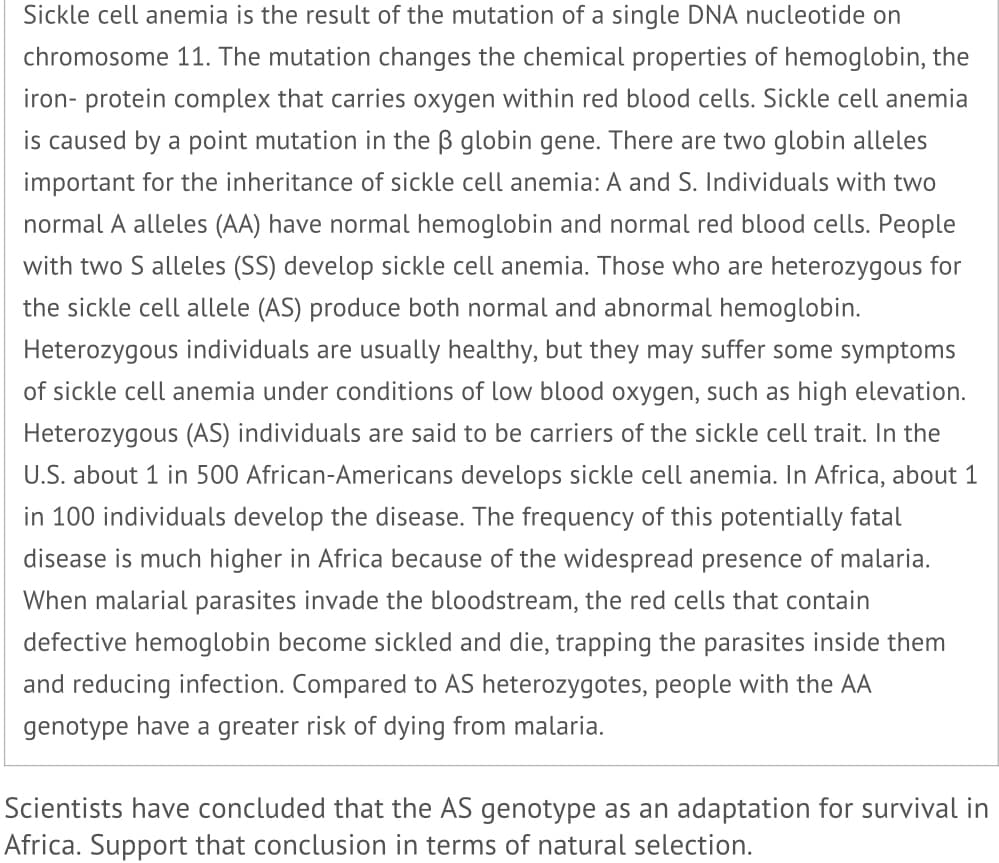Scientists have concluded that the AS genotype as an adaptation for survival in Africa. Support the conclusion in terms of natural selection A. The frequency of the AS allele increases proportionately to the number of Africans in the population B. Because Malaria does not exist in the U.S and the AS allele does not provide any advantage to survival there. C. As the frequency of Malaria increases so does the frequency of the AS allele combination as it protects against getting Malaria D. Those without the AS genotype die out due to sickle cell disease; the populations left with a greater allelic frequency of the AS genotype
Scientists have concluded that the AS genotype as an adaptation for survival in Africa. Support the conclusion in terms of natural selection A. The frequency of the AS allele increases proportionately to the number of Africans in the population B. Because Malaria does not exist in the U.S and the AS allele does not provide any advantage to survival there. C. As the frequency of Malaria increases so does the frequency of the AS allele combination as it protects against getting Malaria D. Those without the AS genotype die out due to sickle cell disease; the populations left with a greater allelic frequency of the AS genotype
Human Heredity: Principles and Issues (MindTap Course List)
11th Edition
ISBN:9781305251052
Author:Michael Cummings
Publisher:Michael Cummings
Chapter11: Genome Alterations: Mutation And Epigenetics
Section: Chapter Questions
Problem 16QP: Familial retinoblastoma, a rare autosomal dominant defect, arose in a large family that had no prior...
Related questions
Question
Scientists have concluded that the AS genotype as an adaptation for survival in Africa. Support the conclusion in terms of natural selection
A. The frequency of the AS allele increases proportionately to the number of Africans in the population
B. Because Malaria does not exist in the U.S and the AS allele does not provide any advantage to survival there.
C. As the frequency of Malaria increases so does the frequency of the AS allele combination as it protects against getting Malaria
D. Those without the AS genotype die out due to sickle cell disease; the populations left with a greater allelic frequency of the AS genotype

Transcribed Image Text:Sickle cell anemia is the result of the mutation of a single DNA nucleotide on
chromosome 11. The mutation changes the chemical properties of hemoglobin, the
iron- protein complex that carries oxygen within red blood cells. Sickle cell anemia
is caused by a point mutation in the B globin gene. There are two globin alleles
important for the inheritance of sickle cell anemia: A and S. Individuals with two
normal A alleles (AA) have normal hemoglobin and normal red blood cells. People
with two S alleles (SS) develop sickle cell anemia. Those who are heterozygous for
the sickle cell allele (AS) produce both normal and abnormal hemoglobin.
Heterozygous individuals are usually healthy, but they may suffer some symptoms
of sickle cell anemia under conditions of low blood oxygen, such as high elevation.
Heterozygous (AS) individuals are said to be carriers of the sickle cell trait. In the
U.S. about 1 in 500 African-Americans develops sickle cell anemia. In Africa, about 1
in 100 individuals develop the disease. The frequency of this potentially fatal
disease is much higher in Africa because of the widespread presence of malaria.
When malarial parasites invade the bloodstream, the red cells that contain
defective hemoglobin become sickled and die, trapping the parasites inside them
and reducing infection. Compared to AS heterozygotes, people with the AA
genotype have a greater risk of dying from malaria.
Scientists have concluded that the AS genotype as an adaptation for survival in
Africa. Support that conclusion in terms of natural selection.
Expert Solution
This question has been solved!
Explore an expertly crafted, step-by-step solution for a thorough understanding of key concepts.
This is a popular solution!
Trending now
This is a popular solution!
Step by step
Solved in 2 steps

Knowledge Booster
Learn more about
Need a deep-dive on the concept behind this application? Look no further. Learn more about this topic, biology and related others by exploring similar questions and additional content below.Recommended textbooks for you

Human Heredity: Principles and Issues (MindTap Co…
Biology
ISBN:
9781305251052
Author:
Michael Cummings
Publisher:
Cengage Learning

Human Heredity: Principles and Issues (MindTap Co…
Biology
ISBN:
9781305251052
Author:
Michael Cummings
Publisher:
Cengage Learning